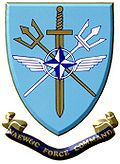NATO Airborne Early Warning & Control Force Command
The NATO Airborne Early Warning & Control Force Command (Naew & C Force Command, in short: Force Command) is a military headquarters of NATO to guide the NATO AWACS -Frühwarnflotte. It is the operational part of the NATO Airborne Early Warning & Control Program , which is run by the NATO AEW & C Program Management Organization (NAPMO).
Seat
The NAEW & C Force Command was located at the Supreme Headquarters Allied Powers Europe (SHAPE) site near Casteau near Mons in Belgium from its establishment in 1980 until 2015 . In October 2015, the headquarters for the management of the AWACS fleet was moved to the NATO airfield Geilenkirchen near Teveren , the home base of the NATO E-3A association.
organization
The NAEW & C Force Command are subordinate to two associations, called Components:
- The multinational NATO E-3A Component in Geilenkirchen near Aachen was set up in 1982, over 3,000 soldiers and civil servants from 15 nations and 16 Boeing E-3 A ( AWACS ) are stationed here.
- The Royal Air Force E-3D component in Waddington / Great Britain has existed since 1992. The association's seven Boeing E-3 Ds are flown by purely British crews and are subordinate to the Force Command for operations.
As bases for operations as well as for training and exercise purposes, NATO operates additional sites in Trapani (Italy), Aktion (Greece), Konya (Turkey) and Ørland (Norway).
tasks
Force Command is responsible for the operational management of both components. This includes planning routine training, participating in international exercises and deploying the force for NATO operations worldwide.
In addition, the operation of the multinational E-3A fleet gives rise to unique responsibilities. Since the Force does not belong to a nation and therefore cannot fall back on the corresponding organizations, the tasks otherwise covered by these must be carried out by Force Command: training of the crews, logistics, the airworthiness of the aircraft, flight safety, the annual budget and infrastructure planning , Creation and maintenance of all regulations and the definition of necessary modernization measures.
staff
Force Command is led alternately by an American or a German major general every three years. The positions in the Force Command and the E-3A Component in Geilenkirchen are distributed proportionally to the respective nations according to the percentage of the budget. From July 1, 2012 to July 1, 2015, German Major General Jochen Both was Commander of the NATO Airborne Early Warning Force Command, and since July 1, 2018, Major General Jörg Wilhelm Lebert has been Commander of the Force Command.
Web links
- official homepage of the command
- Description of the NAEW & C Force ( Memento of November 10, 2001 in the Internet Archive ) in the NATO Handbook. Chapter 14: Key to Organizations and Agencies and Other Subordinate Bodies - Airborne Early Warning.
- Website of the English Association (Component) Royal Air Force (E-3D) [1]
- NATO AWACS spotter Geilenkirchen - private
- Air Force: AWACS
